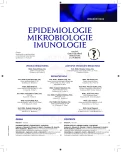Occurrence and characteristic of Staphylococcus aureus in pork meat
Authors:
I. Koláčková; K. Koukalová; R. Karpíšková
Authors‘ workplace:
Výzkumný ústav veterinárního lékařství, v. v. i.
Published in:
Epidemiol. Mikrobiol. Imunol. 63, 2014, č. 3, s. 191-194
Category:
Review articles, original papers, case report
Overview
This study was conducted to evaluate the contamination of raw pork meat with Staphylococcus aureus in retail market and their ability to participate in the creation of foodborne intoxication. Strains were characterized by genotypic traits. Of the 197 samples examined 43 (21.8%) were found to be positive for the presence of S. aureus. Toxigennic properties were found in 21 (48.8%) isolates, the major enterotoxigennic gene found was seh (81%). All the S. aureus isolates were screened for resistance to antimicrobial agents by disk diffusion method and for mecA gene encoding resistance to meticillin. Two of the strains isolated in this study harboured the mecA gene (MRSA). The determination of sequence type 398 (ST398) has been confirmed in both MRSA isolates.
Keywords:
MRSA – detail – enterotoxins – resistance
Sources
1. Agersø Y, Hasman H, Cavaco LM, Pedersen K, Aarestrup FM. Study of methicillin resistant Staphylococcus aureus (MRSA) in Danish pigs at slaughter and in imported retail meat reveal a novel MRSA type in slaughter pigs. Veterinary Microbiology, 2012;157:246–250.
2. Armand-Lefevre L, Ruimy R, Andremont A. Clonal comparison of Staphylococcus aureus isolates from healthy pig farmers, human controls, and pigs. Emerging Infection Diseases, 2005;11:711–714.
3. Bardoň J, Kolář M, Karpíšková R, Žemličková H, Fridrichová M, et al. Occurrence and characteristic of methicillin-resistant Staphylococcus aureus in pig farms in the Czech Republic. Acta Veterinaria, 2012;81:p. doi:10.2754/avb201281030000.
4. Boşgelmez-Tmaz G, Ulusoy S, Aridoğan B, Coşkun-Ari F. Evalution of different methods to detect oxacillin resistance in Staphylococcus aureus and their clinical laboratory utility. European Journal of Clinical Microbiology & Infectious Diseases, 2006;25(6):410–412.
5. Clinical and Laboratory Standards Institute (CLSI) Performance standards for antimicrobial susceptibility teststing. CLSI Document M100-S22. Clinical and Laboratory Standards Institute, USA, Pa, 2012.
6. Huijsdens XW, van Dijke BJ, Spalburg E, van Santen-Verheuvel, MG, Heck ME, et al. Community-acquired MRSA and pig-farming. Annals of Clinical Microbiology and Antimicrobials, 2006;5:26. DOI:10.1186/1476-0711-5-26.
7. Kim NH, Yun AR, Rhee1 MS. Prevalence and classification of toxigenic Staphylococcus aureus isolated from refrigerated ready-to-eat foods (sushi, kimbab and California rolls) in Korea. Journal of Applied Microbiology, 2011;111:1456–1464.
8. Lee JH. Methicillin (oxacillin)-resistant Staphylococcus aureus strains isolated from major food animals and their potential transmission to humans. Applied and Enviromental Microbiology, 2003;6489–6494.
9. Løvseth A, Loncarevic S, Berdal KG. Modified multiplex PCR method for detection of pyrogenic exotoxin genes in staphylococcal isolates. Journal of Clinical Microbiology, 2004;42:3969–3872.
10. Martineau F, Picard JF, Roy HP, Ouellette M, Bergeron MG. Species-specific and ubiquitous-DNA-based assays for rapid identification of Staphylococcus aureus. Journal of Clinical Microbiology, 1998;36:618–623.
11. Monday SR, Bohach GA. Use of multiplex PCR to detect classical and newly described pyrogenic toxin genes in staphylococcal isolates. Journal of Clinical Microbiology, 1999;37:3411–3414.
12. Normanno G, Corrente M, La Salandra G, Dambrosio A, Quaglia NC, et al. Methicilin-resistant Staphylococcus aureus (MRSA) in foods of animal origin product in Italy. International Journal of Food Microbiology, 2007;117:219–222.
13. O´Brien AM, Hanson BM, Farina SA, Wu JY, Simmering JE, Wardyn SE, Forshey BM, Kulick ME, Wallinga DB, Smith TC. MRSA in conventional and alternative retail pork products. PLoS ONE, 2012;7(1):e30092.doi:10.1371/journal.pone0030092.
14. Pesavento G, Ducci B, Comodo N, Lo Nostro A. Antimicrobial resistance profile of Staphylococcus aureus isolated from raw meat: A research for methicillin resistant Staphylococcus aureus (MRSA). Food Control, 2007;18:196–200.
15. Pospíšilová M., Karpíšková R. Případ stafylokokové enterotoxikózy vyvolané netradičním toxinem SEH. Zprávy CEM (SZÚ Praha), 2005;14:84–85.
16. Ren K, Bannan JD, Pancholi V, Cheung AL, Robbins JC, et al. Characterization and biological properties of a new staphylococcal exotoxin. Journal of Experimental Medicine, 1994;180:1675–1683.
17. Růžičková V, Karpíšková R, Pantůček R, Pospíšilová M, Černíková P, Doškař J. Genotype analysis of enterotoxin H-positive Staphylococcus aureus strains isolated from food samples in the Czech Republic. International Journal of Food Microbiology, 2008;121:60–65.
18. Schelin J, Wallin-Carlquist N, Cohn MT, Lindqvist R, Barker GC, Radström P. The formation of Staphylococcus aureus enterotoxin in food environments and advances in risk assessment. Virulence, 2011;2:580–592.
19. Smith TC, Pearson N. The emergency of Staphylococcus aureus ST398. Vector Borne Zoonotic Diseases, 2011;11:327–339.
20. Šťástková Z, Karpíšková R, Gelbíčová T, Vaňáč V, Tůma, et al. Detection of enterotoxigenic genes in Staphylococcus aureus isolated from bulk tank cow´s milk samples in the Czech Republic. Acta Alimentaria, 2012;41:327 – 333.
21. van Belkum A, Melles DC, Nouwen J, van Leeuwen WB, van Wamel W, et al. Co-evolutionary aspects of human colonisation and infection by Staphylococcus aureus. Infection, Genetics and Evolution, 2009;9:32–47.
22. van Wamel WJB, Hansenová Maňásková S, Verbrugh H, van Belkum A. Short term micro-evolution and PCR-detection of methicillin-resistant and susceptible Staphylococcus aureus sequence type 398. Eur. J. Clin. Microbiol Infect Dis, 2010;29:119–122.
23. Voss A, Loeffen F, Bakker J, Klaasen C, Wulf M. Methicillin-resistant Staphylococcus aureus in pig farming. Emerging Infection Diseases, 2005;11:1965–1966.
Labels
Hygiene and epidemiology Medical virology Clinical microbiologyArticle was published in
Epidemiology, Microbiology, Immunology

2014 Issue 3
Most read in this issue
- The current view of the diagnosis and management of amebiasis in the light of the authors’ own case reports
- Infections caused by human alpha herpes viruses
- Enterohemorrhagic Escherichia coli as the cause of diarrhea in the Czech Republic, 1965–2013
- Occurrence and characteristic of Staphylococcus aureus in pork meat
